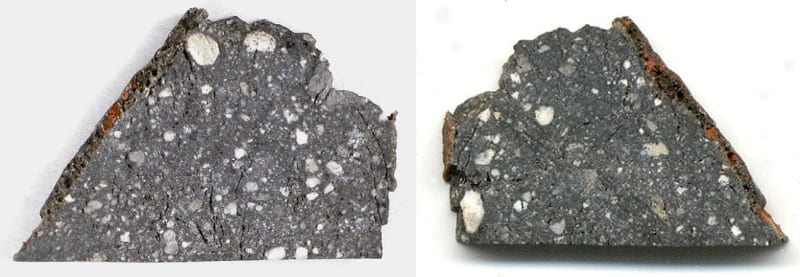Lunar Meteorite: Calcalong Creek






| from The Meteoritical Bulletin, no. 71 Calcalong CreekWiluna District, Western Australia, Australia Lunar meteorite History: A stone of 19 g was found by an Aborigine meteorite hunter in the Millbillillie strewnfield. Physical Characteristics: It has a complete fusion crust, the interior shows a microbreccia with white angular clasts in a dark matrix (impact melt breccia, calculated from the bulk analysis: 50% anorthosite, 20% KREEP, 15% Luna- 16 type low-Ti mare basalt and 15% Sc-Cr-V components). Information and analysis: Fe/Mn = 73-78, KREEP pattern of REE, Dolores H. Hill, Lunar Planetary Laboratory, University of Arizona, Tucson AZ 85726, USA. See also, D. H. Hill, W. V. Boynton and R. A. Haag, Nature, 1991, in press. Specimens: The main mass is with Robert Haag, P. O. Box 27527, Tucson, AZ 85726, USA |
| Randy Says… Because Calcalong Creek is a regolith breccia, it has a vesicular fusion crust, as do some lunar meteorites from Antarctica. The vesicles form from release of solar-wind implanted gases during the heating melting of the exterior associated with atmospheric entry. The meteorite is compositionally distinct from Lynch 002, the only other lunar meteorite from Australia, but similarly rich in incompatible elements like Th. The two Australian lunar meteorites were found 859 km apart.  |
More InformationMeteoritical Bulletin Database References Hill D. H. and Boynton W. V. (2003) Chemistry of the Calcalong Creek lunar meteorite and its relationship to lunar terranes. Meteoritics & Planetary Science 38, 595-626. Hill D. H., Boynton W. V., and Haag R. A. (1991) A lunar meteorite found outside the Antarctic. Nature 352, 614-617. Hill D. H., Marvin U. B., and Boynton W. V. (1995) Clasts from the Calcalong Creek lunar meteorite. Lunar and Planetary Science XXVI, 605-606. Korotev R. L, Zeigler R. A., Jolliff B. L., Irving A. J., and Bunch T. E. (2009) Compositional and lithological diversity among brecciated lunar meteorites of intermediate iron composition. Meteoritics & Planetary Science 44, 1287-1322. Pernet-Fisher J. F., Nottingham M., Curran N. M. , and Joy K. H. (2020) Cosmic-ray exposure histories of Th-rich lunar regolith breccias. 51st Lunar and Planetary Science Conference, abstract no. 1376. |